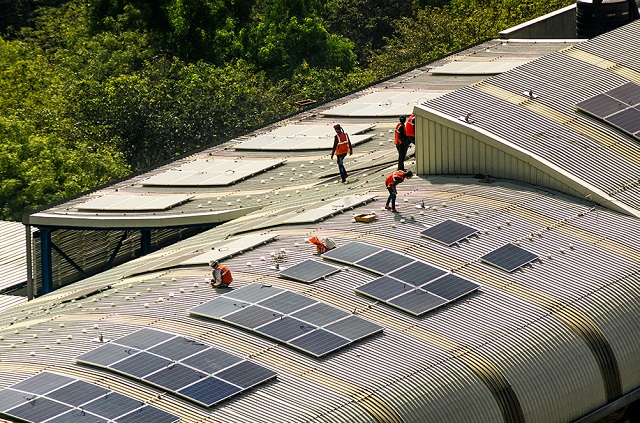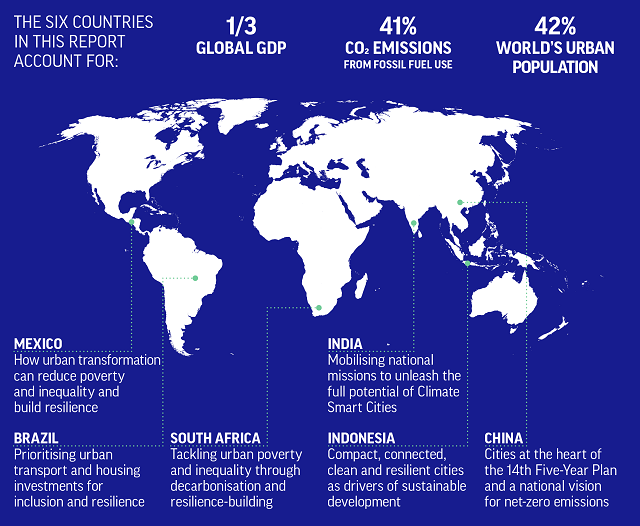
National governments face an enormous triple challenge right now: recovering from COVID-19, creating sustainable and inclusive development, and addressing the climate crisis. New research shows that focusing on cities is key to overcoming these challenges while generating considerable economic, social and environmental benefits.
A report by the Coalition for Urban Transitions, Seizing the Urban Opportunity, finds that implementing a bundle of currently available technologies and practices across six emerging countries — China, India, Indonesia, Brazil, Mexico and South Africa — could collectively cut annual emissions from key urban sectors by 87–96% by 2050 beyond countries’ initial commitments under the Paris Agreement. Equally important, they could provide economic returns with a net present value of more than $12 trillion by 2050 based on direct energy and material cost savings alone and potentially support 31 million new jobs in 2030.

In order to achieve these benefits, though, cities in emerging countries must have the full support of national governments. Here are six ways national governments can help cities accelerate decarbonization, recover from COVID-19 and enhance resilience:
1. Develop a national net-zero economic development strategy — and place cities at its heart.
Nothing impedes progress more than a disjointed approach. To spur action and investments across sectors and ministries, a shared national vision is crucial. A national net-zero development strategy ensures all geographical areas in a country take the same level of climate action and are working toward the same goal. As economic engines that produce 80% of the world’s GDP and are home to 56% of the world’s population, cities will need to be at the core of national net-zero strategies.
National governments could learn from South Africa’s Long-Term Low Emissions Development Strategy (SA-LEDS), which aims to transform South Africa’s economy and reach net-zero emissions by 2050. It includes nationwide initiatives such as the National Energy Efficiency Strategy, which provides incentives and support mechanisms to drive uptake of clean energy technologies such as solar water heaters for low-income families in many of South Africa’s core urban centers. The country’s nationwide approach also means that successful initiatives such as Johannesburg’s bus rapid transport system can be adapted and implemented in other major cities.
2. Pursue national policies to support cities that are compact, connected, clean and resilient.
Urban transformation toward more compact, connected, clean and resilient cities can support a wide range of development priorities, including enhanced economic competitiveness, improved public health, higher living standards and reduced pollution. It is vital that governments introduce national policies that prevent urban sprawl, which creates a barrier for provision of municipal services.
India is one country that has pursued national policies to support urban transformation. Its National Mission for Sustainable Habitat aids cities in tackling climate risk and fostering clean, inclusive and sustainable development. Meanwhile its new Climate Smart Cities Assessment Framework uses 28 indicators to assess cities’ vulnerabilities and potential for action on energy and green buildings, urban planning, green spaces and biodiversity, mobility, air quality, water and waste management. Nearly 100 cities across the country now use the tool’s knowledge-sharing platform to learn from each other’s experiences and implement best practices to create a more compact, connected and clean city.
3. Fund and finance green urban infrastructure.
Funding sustainable and resilient urban infrastructure such as public transport and green buildings offers the potential for enormous economic returns to national governments as a result of energy and material savings. For instance, in Indonesia, urban emissions could be reduced by 50% in 2030 and 96% in 2050 using proven low-carbon measures, such as establishing public transport systems and developing walking and biking infrastructure. Economic modeling suggests that implementing the low‑carbon measures would need incremental investments of $1 trillion by 2050, but could provide returns with a net present value of $2.7 trillion by 2050 based on energy and material cost savings alone.

Buildings and passenger transport provide the greatest potential for emissions reduction. In Indonesia, measures to encourage compact urbanization and reduce travel demand, would require $24.4 billion in incremental investment by 2050, but would yield energy and material savings with a net present value of $731.2 billion. Given that Indonesia has announced it will build a new capital city in Borneo, a unique opportunity has presented itself for the country to reap the benefits of compact, connected, clean and resilient urbanization.
4. Support local climate action in cities through governance and fiscal reforms that enable local government leadership and facilitate collaboration.
In order to create an environment that empowers local leaders and mayors to take even greater action on climate, national governments can push through policy and fiscal reforms to secure investment and create metropolitan authorities to foster collaboration and an integrated approach.
For instance, in South Africa, reforming the Electricity Regulation Act should soon enable municipalities to procure their own clean energy, thereby improving access to renewables. Some municipalities such as eThekwini, which encompasses the city of Durban, now plan to build their own renewable generation capacity mainly from wind and solar, reducing their reliance on the central grid system.
In Mexico, governance reforms, such as the creation of the Guadalajara Metropolitan Authority, has improved integrated land use and transport planning and expanded the supply of affordable public transport. Creating metropolitan authorities builds the capacity of municipal staff. As much of Mexico’s growth is occurring in smaller cities, national support — including technical assistance, funding and governance reforms to facilitate collaboration between ministries — can ensure that these growing cities are compact, connected, clean and resilient.
5. Prioritize measures that build resilience and expand economic opportunities for the poor.
National governments should not be fearful that there will be job losses from the transition to a low-carbon economy. Decarbonizing cities has the potential to create millions of new jobs and could catalyze a just transition. Recent analysis from Vivid Economics for the Coalition for Urban Transitions found that about 31 million new jobs could be created in 2030 in China, India, Indonesia, Brazil, Mexico and South Africa by adopting low-carbon measures modeled in the report versus the business-as-usual alternative.
Low-carbon urban measures, such as retrofitting buildings, could create an estimated 8-21 jobs per $1 million spent in energy efficiency measures, in comparison to three jobs in the fossil fuel sector. National governments will need to support cities so that informal workers and others in precarious conditions get to share in the benefits of the green transition and are not unintentionally disadvantaged. To do this, revenues from carbon taxes or fossil fuel subsidy reform can be used to develop transition plans for workers in the fossil fuels industry.
6. Work with the private sector to help finance urban transformation.
In order to meet the financing gap for sustainable urban infrastructure, we’ll need a significant increase in investment both in the public and private sectors. It will pay dividends, though, as investing in sustainable, inclusive cities globally could be an economic opportunity worth at least $24 trillion by 2050. National governments can promote policies that stimulate and de-risk private sector investment and encourage public-private partnerships.
The payoffs for taking these measures will outweigh the costs. For instance, the transport sector in Brazil holds 45% of the nation’s urban emissions-reduction potential to 2050. Shifting travel from cars to public transit in Brazil would need a cumulative investment of $29.6 billion by 2050, but could yield returns with a net present value of $223.3 billion. Similarly, shifting to electric vehicles could support an estimated 128,000 jobs in the country in 2030. Cities are already adopting electric buses and waste disposal trucks to capitalize on this opportunity. The Brazilian government could follow the lead of China, which recently approved $729 billion in fiscal stimulus to accelerate the rollout electric vehicles and associated infrastructure, support building renovations and upgrade railways. In China, initial targeted subsidies for purchases of EVs has brought more companies into the market and attracted investment.
Capitalizing on the Opportunity
In the midst of the greatest global economic downturn in nearly a century, progress on sustainable development needs to be regalvanized, and the low-carbon transition sped up. Now is the moment for national governments to build back stronger, fairer and greener than before.
Cities’ role as economic engines, combined with the fact that the urban poor were particularly hard hit by COVID-19, means that urban centers must be at the heart of a long-term plan for sustainable and inclusive development.
National governments have a central role in unlocking cities’ vast potential. We urge leaders in all countries to support cities in solving their triple challenge: stimulating the economy, alleviating poverty and inequality, and transitioning to net-zero emissions.
This blog originally appeared on WRI’s Insights.
The Coalition for Urban Transitions is a special initiative of the New Climate Economy jointly hosted and managed by WRI Ross Center for Sustainable Cities and the C40 Cities Climate Leadership Group.
Nick Godfrey is the Director of the Coalition for Urban Transitions.
Robin King is the Director of Knowledge Capture and Collaboration at WRI Ross Center for Sustainable Cities.
Freya Stanley-Price is the Communications Manager for the Coalition for Urban Transitions.





